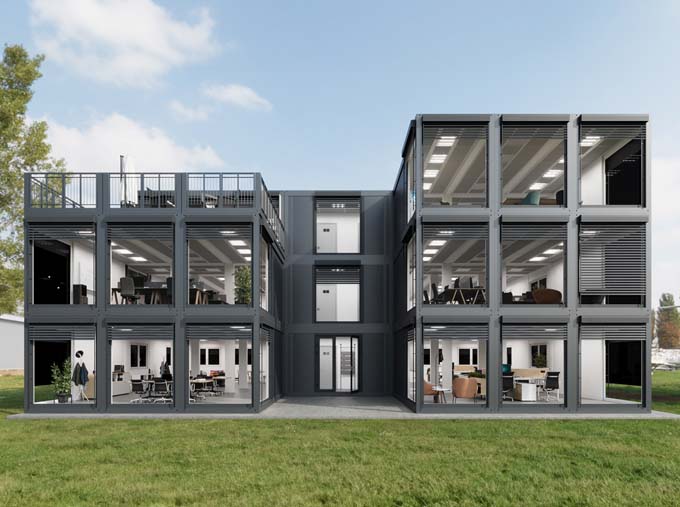Heat pump follows the path of the sun
Today, new buildings in Switzerland are predominantly equipped with a heat pump to generate heating and hot water. When existing buildings are renovated, such a device is used in around one in four cases. Heat pumps are thus the preferred alternative to fossil-fuelled gas and oil heating systems.

The University of Applied Sciences Northwestern Switzerland in Muttenz (BL) has now investigated how heat production with heat pumps can be supported by solar energy.
In May 2017, voters approved the new Energy Act. In doing so, they voted for more renewable energies and better energy efficiency. Political decisions usually unfold their effects gradually. In the area of heat pumps, positive effects are now tangible. Heat pumps use the heat contained in the air, the ground and groundwater to provide heating and hot water - using electricity to drive a compressor - as well as cooling energy. Since they do not require the fossil fuels oil and gas, they meet the objectives of current energy policy.
The sale of heat pumps has increased significantly after the vote year 2017: Almost 22,000 heat pumps were sold in Switzerland in 2018, around 10% more than in the previous year. This is remarkable, as sales had been trending downward since the record year of 2008 (20,670). "You probably can't attribute this turnaround to a single event," says Stephan Peterhans, managing director of the Swiss Heat Pump Association (FWS), "but the political discussion about the energy and CO2 laws have given new impetus to the use of heat pumps. In addition, virtually all cantons now have subsidy programs for heat pumps."



Powered by solar electricity
Heat pumps are based on a proven technology. However, the potential for a sustainable energy supply has not yet been exhausted. In addition to electricity from the grid, solar power can also be used directly to operate heat pumps. The importance of solar power can be demonstrated with a realistic example: The Huber family needs 10,000 kWh of heat annually for heating and hot water in their single-family home (150 m2 living space). The heat is generated with an air-to-water heat pump (7 kW heating capacity), using 3000 kWh of electricity. The Hubers' house is equipped with a photovoltaic system (5 kWp) that provides 5000 kWh annually, and a battery with 5 kWh capacity. The renewable electricity is used to run the heat pump whenever possible, but besides that it is also used for household electricity (annual demand: 3000 kWh).
The figures show: The relatively small PV system produces more electricity over the year than the heat pump consumes. However, since the solar power is not always produced at the times when the heat pump is usually in operation, the Huber family's heat pump often runs on grid power. What is common today can be changed with an energy management system: With an intelligent control system, one could increase the self-consumption of PV electricity by scheduling the heat pump's operating hours to times when PV is producing. A team from the Institute for Energy in Buildings (IEBau) at the University of Applied Sciences Northwestern Switzerland (FHNW) has now investigated the effects of such energy management systems and the boundary conditions that influence them. The study, which was supported by the Swiss Federal Office of Energy, was completed at the end of 2018.
Intelligent control reduces grid consumption
A central result of the study: If the heat pump is operated by intelligent control when PV electricity is produced, the purchase of grid electricity in the house can be reduced by up to 3 percentage points overall by changing the heat pump operation. In this way, the self-supply ratio by PV electricity increases from 47 to 50%. With reference to the above example, this means in absolute figures: Instead of 2820 kWh, 3000 kWh of the 6000 kWh electricity needed by the household over the year now comes from the PV system.
"From the point of view of the electricity customer, a reduction of 3% in grid purchases is relatively little and does not create an effective monetary incentive," says study leader Ralf Dott, adding, "The situation is different from other perspectives, for example, from the point of view of the grid operator: if a large number of households increase their own consumption, this can result in noticeable relief for the distribution grid." According to the FHNW researcher, the study is meaningful for single-family homes, but also for smaller apartment buildings with up to ten residential units. In houses with several residential parties, the increase in self-consumption tends to be easier and greater because the hot water is used more evenly over time thanks to the large number of users, says Dott.
The detailed version of the technical article "Heat pump follows the course of the sun" is available on www.bfe.admin.ch/ec-wp-kaelte (see section 'Heat pumps and cooling')
Data from the four-day measurement campaign of a heating system whose heat pump is fed with solar power, among other things:
The top graph shows that the PV system generates more electricity during the afternoon hours than is needed in the household (red curve). Part of this electricity is then used to operate the heat pump (blue curve). The middle graph shows that the PV system feeds electricity into the grid during the afternoon hours - and this is still the case when the PV electricity is used to operate the heat pump.










